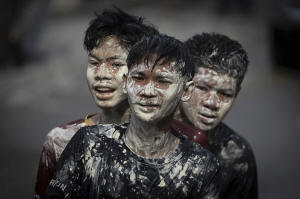Southeast Asia water festivals begin, but earthquake recovery blunts
Myanmar's celebrations
[April 14, 2025]
By GRANT PECK
BANGKOK (AP) — Several Southeast Asian countries kicked off their annual
water festival holiday on Sunday, but in the wake of a devastating
earthquake last month, Myanmar is missing out on the fun.
The holiday is an occasion for merrymaking during what is usually the
hottest time of the year. In Thailand, Laos, Cambodia and Myanmar,
millions normally take part in a mix of raucous play with uninhibited
splashing of water on friends and strangers alike, and sober ceremonies
to show respect to one’s elders.
Temperatures this time of year can creep above 40 degrees Celsius (104
Fahrenheit). Many who have moved to cities for work return to their
native villages and towns to reunite with their families. The
celebration is normally spread over several days, culminating on the
actual New Year’s Day.
In Myanmar, the holiday is called Thingyan. But this year, the country
is struggling to recover from the 7.7 magnitude earthquake on March 28
that devastated its central heartland, killing more than 3,600 people
and leveling structures from new condos to ancient pagodas.
Central Myanmar was shaken again on Sunday by a 5.5 magnitude earthquake
in one of the biggest aftershocks since the March 28 temblor.
Even before last month's quake, Myanmar was reeling from a repressive
military that seized power in 2021 and is carrying out a brutal war on
the pro-democracy forces trying to unseat it. In 2020, the pandemic also
quashed celebrations.

Still, the holiday offered a brief respite from the grim struggles of
daily life in one of the region's poorer countries, and this is the
first year Myanmar could celebrate Thingyan's inclusion on the UNESCO
Representative List of Intangible Cultural Heritage of Humanity, an
honor attained last December.
A few days after the quake, the military government announced that this
year’s festival would be observed peacefully in pursuit of traditional
culture and would not include joyous singing and dancing, due to a
nationwide grieving period.
People are free to celebrate privately and quietly, and items related to
the festival, including water guns, are being sold in malls and stores.
However, there is no government-organized entertainment. In Yangon, the
country’s largest city, major festival pavilions and decorations that
were already being built in front of the City Hall were dismantled.
People’s Square, a major celebration spot in Yangon, will not host the
festival this year, but a traditional charity feast will be held without
music and dance, the state-run Global New Light of Myanmar newspaper
reported on Thursday.
[to top of second column]
|

Thai people with faces stained with paint take part in the Songkran
water festival to celebrate the Thai New Year in Prachinburi
Province, Thailand, Sunday, April 13, 2025. (AP Photo/Wason
Wanichakorn)

In Yangon, the downtown area near City Hall was quiet, in sharp contrast
to many past occasions.
The only visible signs of the holiday were the sights of children
playing with water in the streets of residential neighborhoods, and
mostly elderly people going to Buddhist monasteries and pagodas for
traditional prayers.
In the capital, Naypyitaw, state-media reported Saturday that a quiet
celebration of the holiday’s recognition by UNESCO would include events
such as applying Thanaka, a yellowish-white paste made from ground tree
bark as a traditional natural cosmetic, gently washing the heads and
cutting the nails of elderly people as a gesture of respect, and
donating food.
Neighboring Thailand, where the holiday is called Songkran, was expected
to celebrate with revelry as usual. It sees a mass exodus of the
workforce in the capital, Bangkok, return to their upcountry home towns,
often extending what is officially a three-day holiday into an entire
working week.
Foreign tourists join locals in almost orgiastic water fights,
especially in Bangkok’s Khao San Road backpackers district. Water
pistols are merely small arms. It is not unusual to see huge buckets of
water dumped on any convenient target. Moving vehicles serve as both
platforms and targets for attacks.
The holiday is historically pegged to a seasonal movement of the sun,
critical to largely agrarian societies. The water hijinks originated in
olden days as a ceremony to welcome rainy season. A traditional ritual
still practiced by many involves cleansing images of the Buddha and
washing the hands and feet of elders.
There is a darker side to the goings-on, as well. Thailand already has
one of the world’s highest rates of traffic fatalities, which spikes
during Songkran with so many on the move and often inebriated.
Cambodia, where the holiday is called Choul Chnam Thmey, and Laos, where
it is Pi Mai Lao, have similar celebrations, generally smaller in scale
and less raucous than those in Thailand.
——-
Associated Press writer Sopheng Cheang in Phnom Penh, Cambodia,
contributed to this report.
All contents © copyright 2025 Associated Press. All rights reserved |